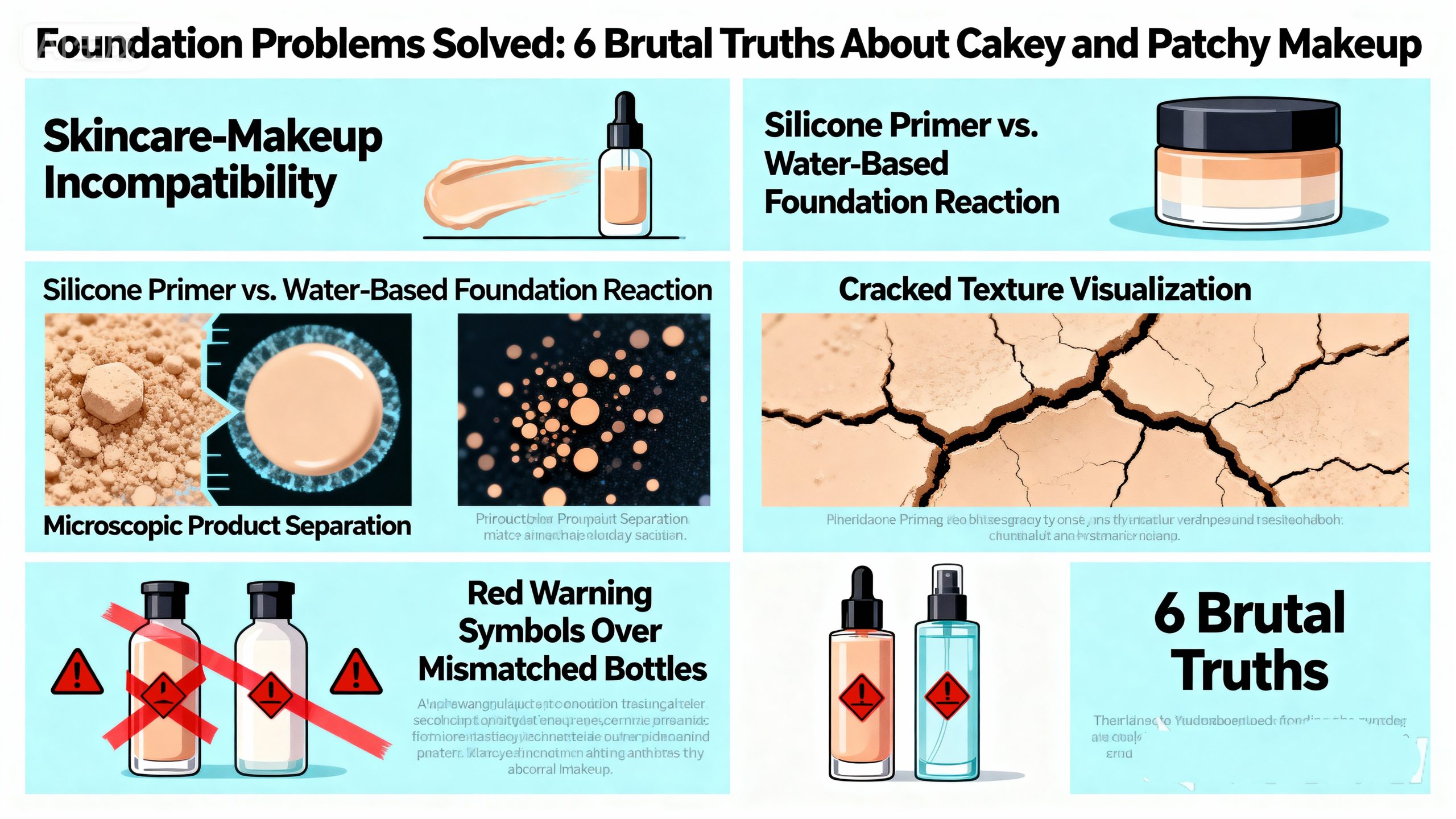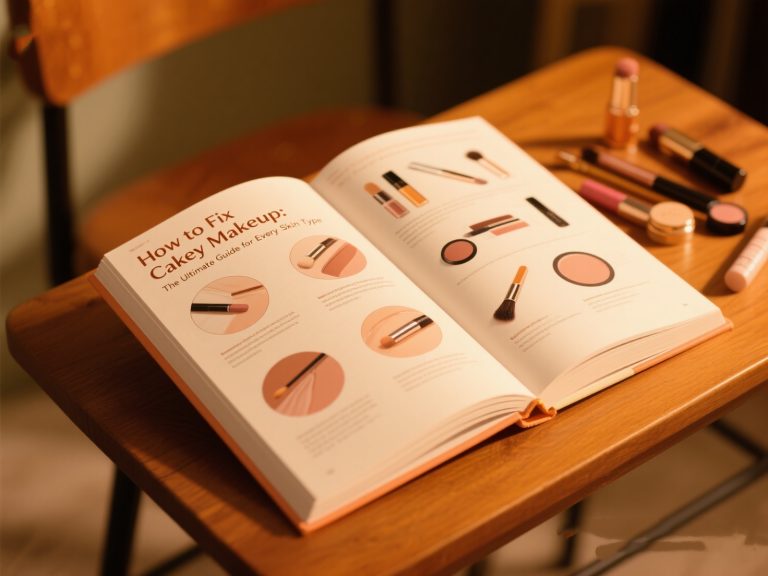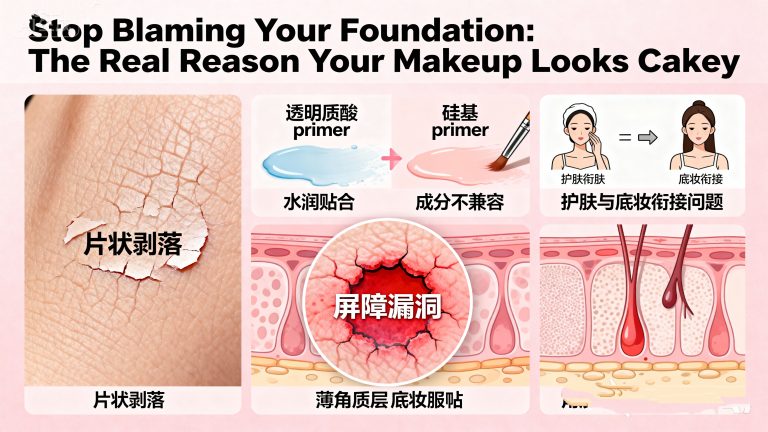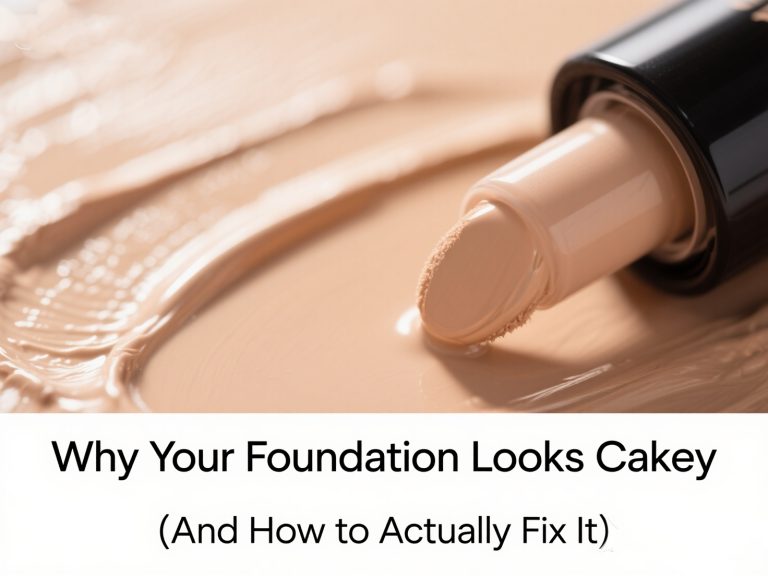Foundation Problems Solved: 6 Brutal Truths About Cakey and Patchy Makeup

Look, we need to talk about your foundation.
It’s September again. Seasonal changes. Your skin is freaking out. And suddenly, that foundation you loved in summer looks like cracked plaster.
I get it. Ten years ago, I’d slap foundation on with my bare hands and call it a day.
Those were the glory days.
Now? Foundation is the most stressful part of my routine. Because unlike eyeshadow or liner, you can’t just blend out a bad base. It’s either right or you’re starting over.
Here’s the Reality
I’m combination oily in summer, combination dry in winter.
Translation: I deal with both cakey AND patchy foundation. Seasonally. Like clockwork.
So yeah, I’ve figured some stuff out.
Let’s skip the theory you’ve already read a hundred times. We’re going straight to solutions that actually work.
The Two Foundation Disasters (And How to Fix Them)
Problem 1: Cakey Foundation
What it looks like: Your foundation settles into every line, wrinkle, and pore. It’s literally highlighting texture you didn’t know you had.
Where it happens:
- Under-eye area and laugh lines
- Around the nose
- Around acne and scarring
Problem 2: Patchy Foundation
What it looks like: Your foundation separates from your skin. It sits on top rather than melting in. Usually happens where you get oily.
Where it happens:
- T-zone (forehead, nose, chin)
- Nose specifically
- Eyelid creases if you have hooded or deep-set eyes
Now let’s fix these disasters one by one.
Fixing Cakey Foundation
Issue 1: Under-Eye Lines and Laugh Lines
Here’s what nobody tells you: water isn’t the answer. Oil is.
Your skin produces oil to lock in moisture. But if you’re dry, you’re not producing enough.
So piling on hydrating serums before makeup? That’s just making things worse. You’ll get pilling, sliding foundation, and yes, more caking.
The actual solution:
Keep your pre-makeup skincare minimal.
Use a thin layer of facial oil after your toner. Not thick cream. Not multiple serums. Just oil.
Let me break down my routine:
- Toner
- One thin layer of facial oil
- Moisturizer
- Sunscreen
- Done
For problem areas like under-eyes and laugh lines, massage in a bit more oil. Wait 30 seconds. Gently wipe off excess with a damp cotton pad.
You want your skin to feel soft and smooth, but not greasy.
Emergency fix when you’re already caked:
Use a clear lip balm.
Remove foundation from the cakey area with a cotton swab. Apply a tiny amount of lip balm. Blot with tissue. Reapply foundation lightly.
Takes 5 minutes. Looks fresh again.
Issue 2: Foundation Caking Around Acne
Let me be real: you shouldn’t wear makeup over active acne.
But life happens. Job interviews. Dates. Important meetings.
So here’s how to do it without looking like a texture map:
Step 1: Remove dead skin
Apply a thick layer of moisturizer around the blemish. Wait one minute. Gently massage in circles. Wipe away with a cotton pad.
This removes flaky skin without harsh scrubbing.
Step 2: Apply concealer properly
Mix concealer shades on your hand until you get something close to your skin tone, but slightly brighter.
Load up a concealer brush. Press it onto the raised area in one motion. Like stamping.
Wait 10 seconds. Don’t touch it. Let it grip the skin.
Step 3: Blend edges only
Here’s the trick: use the handle end of your brush to blend the edges. Not the bristles.
Why? Bristles will disturb the concealer you just set. The handle won’t.
Blend outward from the covered area. Don’t touch the center.
Issue 3: Nose Creases (The Universal Problem)
That area where your nostril meets your face? Everyone has foundation issues there.
I have a flat nose bridge, so this area is basically a right angle. Foundation loves to cake there.
After trying everything, here’s what actually works:
Method 1: The Proper Way
Apply a damp cotton pad to your entire nose before skincare. Let it sit for a minute. Wipe downward.
This softens dead skin buildup. Do this 2-3 times a week, not daily.
After your regular skincare, apply a thin layer of silicone-based primer to the nose creases. It fills in texture.
Press a clean, dry makeup sponge over the primer. This removes excess and sets what remains.
Now take a small, dense brush. Load it with foundation. Press it into the nose creases in a tapping motion, perpendicular to the skin.
Don’t sweep. Press.
Bend your nose up while doing this. Get into every angle.
Setting is critical:
Use a small, tapered brush. Load it evenly with loose powder. Shake off excess. Roll the brush from the top of your nose down toward the creases. Use the tip to press powder into the deepest parts.
Method 2: The Lazy Way (My Go-To)
Apply the heaviest layer of foundation on the top of your nose. Use the residue on your brush for the creases. Whatever’s left can barely touch the deepest parts.
One sentence summary: heavy coverage on the nose bridge, barely-there coverage in the creases.
The downside? This won’t cover redness in the creases. But it won’t cake either.
Works best if your skin is in decent shape.
Fixing Patchy Foundation
Cakey foundation happens when skin is too dry. Patchy foundation happens when skin is too oily.
Issue 1: T-Zone Separation
This happens because you either:
- Applied too much product
- Didn’t press it into skin properly
When oil breaks through, foundation lifts right off.
The solution is stupidly simple:
Keep pre-makeup skincare light in your T-zone. Use oil-free products. Choose a matte sunscreen.
Apply foundation normally on your first pass. Use a sponge or brush to press it in.
Second pass (this is key):
Spray your makeup tool with setting spray. Go over your T-zone again with the damp tool.
This picks up excess foundation AND sets what remains. Two birds, one stone.
That’s it. Your foundation won’t separate.
Issue 2: Nose (The Most Visible Disaster)
When your nose gets patchy, everyone can see it.
Plus, large pores mean you’re not just seeing separation. You’re seeing every blackhead and whitehead floating to the surface.
The golden rule for preventing patches: Get foundation as close to your skin as physically possible.
The application method:
Nose pores point upward. Apply foundation in downward strokes against the pore direction.
On the sides of your nose, rub foundation in circles against the pore direction. Be aggressive. Don’t be gentle.
Then use a damp sponge to press everything smooth.
Finish with powder.
Unless you’re extremely oily, patches won’t happen.
“Won’t this clog my pores?”
No. As long as you remove your makeup properly at night, you’re fine.
We’ve covered this before. Clean your face. You’ll be okay.
Issue 3: Eyelid Creases (For Hooded Eyes)
If you have hooded eyes or deep-set eyes, foundation settles into your crease within minutes.
I have a friend who went on a date once. The guy told her she had something on her eyelid and tried to wipe it off.
He couldn’t. It was foundation. Mixed with shimmer.
She never forgot that moment. Neither did I.
The fix:
After applying foundation to your lids, press a tissue over them. This absorbs excess oil and clears the crease.
Press, don’t wipe. Wiping destroys your base.
Dampen a cushion puff. Pick up translucent powder. Press it into your eyelids, focusing on the crease.
A damp puff presses powder deeper and absorbs oil simultaneously.
This prevents creasing without affecting your eyeshadow colors later.
Choosing the Right Products
Technique only gets you so far. Product choice matters.
For Dry Skin
Priority: hydration and slip
Dewy, luminous foundations work best. They contain more emollients.
Lightweight options:
- Estée Lauder Futurist Hydra Rescue
- Make Up For Ever Water Blend
- MAC Studio Radiance
These have minimal coverage. Best for good skin days.
More coverage:
- Lancôme Teint Idole Ultra Wear Care & Glow
- Bobbi Brown Skin Long-Wear Fluid
- NARS Light Reflecting
- Guerlain Parure Gold
These create that creamy, slightly glowy finish.
Primers that actually help:
Estée Lauder Futurist Hydra Rescue primer keeps you moisturized for 8+ hours.
DECORTÉ AQ primer is extremely hydrating. No color correction, just hydration.
Ipsa Moisture Stick works pre- and post-makeup. Use it on dry patches before foundation. Use it on cakey areas after foundation to smooth things out before touch-ups.
For Oily Skin
Priority: oil control and staying power
Matte, long-wear foundations are your friend.
Proven performers:
- Estée Lauder Double Wear (the original for a reason)
- Tom Ford Traceless Perfecting Foundation
- Shu Uemura Unlimited Foundation
- Make Up For Ever Matte Velvet Skin (fast-drying, natural finish, slow oxidation)
Primers that actually work:
NARS Oil-Free Moisturizer. Yes, it’s technically moisturizer. But it’s water-based and creates a grippy base. Your foundation won’t budge.
Tom Ford Shade Illuminate Primer creates a smooth, pore-blurring base. A little goes a long way, so the price is less painful.
It slows oil production and refines your texture. Your finish looks more polished than foundation alone.
The Bottom Line
Foundation problems aren’t mysterious. They’re fixable.
Cakey foundation? You’re too dry or using too much product in textured areas.
Patchy foundation? You’re too oily or not pressing product into your skin.
The solution isn’t always buying new products. Sometimes it’s just changing how you apply what you already own.
But when products matter, don’t cheap out on primer. It’s the difference between foundation that lasts and foundation that fails.
Stop fighting your skin. Work with it instead.





